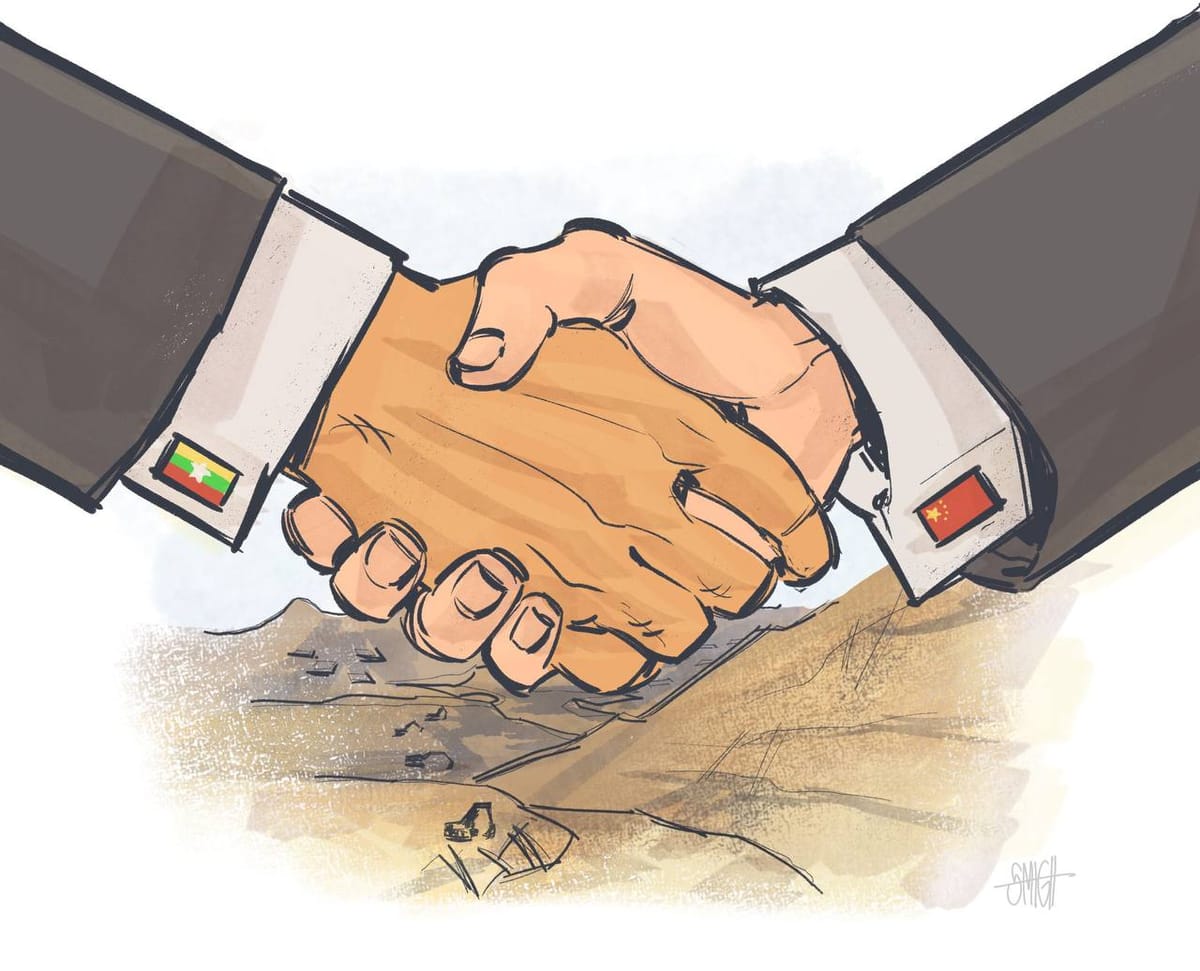
If you've been to Panwa, Shwe Lor, or Chipwi in Kachin State, you would see huge crater-like pits covered with tarpaulins - these are mining sites. It might be hard to believe that these sites are connected to the essential gadgets of our modern world like phones and laptops. But it's true.
This is because these crater-like pits in Kachin State are rare earth mineral mining sites, and the rare earth minerals extracted from here are used in phones and laptops.
There's a global race for rare earth minerals today. On one side, Myanmar is producing rare earth minerals en masse. According to Global Witness's 2024 report, rare earth mineral production in Myanmar increased by 40% between 2021 and 2023.
So, what are rare earth minerals? Where are they mined? Who is mining them? Why is there a rush to produce them? What's the global market situation, and what are the negative impacts? Let's take a look.
What are Rare Earth Minerals?
Rare earth minerals are called "Rare Earth" in English. There are 17 elements in the rare earth group, and they're all called rare earth minerals. Among these, Dysprosium and Terbium are commonly used.
In Myanmar, rare earth minerals are mostly produced in the Panwa area of Chipwi Township, Kachin State. The Panwa area is Special Region (1), controlled by people's militias. It's reported that there are numerous rare earth mineral mining sites there. There are also many in Tanintharyi Region. There are also abundant rare earth minerals in Northern Shan State, Monywa, Kawlin, and Wuntho areas.
In fact, rare earth minerals are abundant in the Earth's upper crust. They're not only found in Myanmar. The nature of rare earth minerals (rare earth elements) is that they don't exist alone but are mixed with other elements, so they need to be separated. This separation process is extremely costly. The most cost-effective method is called In-Situ Leaching.
How are Rare Earth Minerals Extracted?
There are some key chemicals needed when producing rare earth minerals. These are ammonium sulfate and oxalic acid. Rare earth mineral producers in Myanmar mainly import ammonium sulfate and oxalic acid from China.
The import of chemicals used in rare earth mineral production in Myanmar has increased many times over in nearly a decade. For example, in 2015, only over 90,000 tons of ammonium sulfate were imported, but in 2023, it reached 1.5 million tons. Similarly, oxalic acid imports increased from 342 tons in 2015 to 174,000 tons in 2023.
In fact, rare earth mineral production involves the use of these potentially toxic chemicals. So how can rare earth minerals be produced?
There are various methods to produce rare earth minerals. Mainly, they're produced using geological methods. Initially, they have to study and analyze whether rare earth minerals exist. They have to take rock samples, soil samples, and test the sediments. Then, they have to do geological mapping and rock type classification. This is just a general overview, and only expert professionals would know the detailed process.
However, the In-Situ Leaching method is said to be the most cost-effective among all rare earth mineral extraction methods. This method involves drilling into mountains. First, if there are forests or trees on the mountains, they need to be cut down. Then, they drill holes into the mountains and pour ammonium sulfate into them. The liquid produced from the reaction with the soil is channeled through pipes to large pits covered with tarpaulins at the foot of the mountains. Then, they filter out the rare earth elements.
The In-Situ Leaching method has been used in China since around 1980. This method destroys farmlands, and the acidic residues and toxic chemical remnants enter streams, severely damaging the natural environment. Now, this method is only allowed with quotas in China. They can only operate under strict regulations, including acid leakage standards.
However, while the Chinese have to produce rare earth minerals with strict methods in their country, they're allowed to extract in Myanmar without regulations or laws. This raises questions about the enforcement of regulations and laws by the Ministry of Environmental Conservation.
Whatever the case, the poor locals living in the rare earth mineral production environment are suffering these consequences. According to Global Witness's interviews, most workers in the entire mining area are suffering from coughs, numbness, and skin and kidney problems.
After the military coup, rare earth mineral mining in Kachin State has gradually expanded from Kachin Special Region 1 Panwa to Chipwi Township, and now it has expanded to Moemauk Township south of Chipwi.
Global Trends in Rare Earth Minerals
Today's world is heavily using rare earth minerals. Especially for modern society's essential items like phones, computers, TVs, rechargeable batteries used in electric cars. Rare earth minerals are also used in oil refining, CD scanning, defense and military applications, underwater exploration, intelligence operations, and radar. They're also used in other electrical appliance production and glass industries.
Rare earth minerals are not only found in Myanmar. They're also abundant in the United States, China, India, Brazil, and other countries.
While poor countries like Myanmar produce thousands of tons of rare earth minerals annually, wealthy countries store their rare earth minerals without extracting them. This is more accurate if we say they're foreseeing the future importance and preserving their mineral resources without touching them.
For example, a financially strong country like China doesn't produce large tons of rare earth minerals in their country. They maintain emergency stocks and buy from other countries. Brazil and India have hundreds of thousands of tons of rare earth minerals. But they only extract 1000-2000 tons per year.
In today's world, China is the largest buyer of rare earth minerals from Myanmar. Everyone probably knows this. According to the US Geological Survey (USGS), Myanmar exported about 5,000 tons of rare earth minerals to China in 2018 alone.
China doesn't just buy from Myanmar; they also purchase rare earth minerals from Laos and Malaysia.
Unworthy Natural Resources
Myanmar has always been said to be rich in natural resources, which is indeed true. But if you ask whether these resources benefit the country or its citizens, it's a rather sad issue to answer.
Myanmar has many resources like the Mogok gem land, Myanmar teak including various hardwoods, offshore natural gas, fertile and vast river delta plains suitable for agriculture. However, poor management and lack of vision have hindered the ability to extract and benefit from these resources. This is also called the resource curse.
Today, rare earth minerals can also be called a cursed gift from God suffering from such a resource curse. While neighboring China is freely mining and benefiting from rare earth minerals in Kachin State and Tanintharyi, Myanmar citizens will have to pay a huge price for this in the not-too-distant future.
Han Thit Eain (Y3A)
Build Myanmar-Media: Insights – Empowering Myanmar Youth, Culture, and Innovation
Build Myanmar-Media Insights brings you in-depth articles that cover the intersection of Myanmar’s rich culture, youth empowerment, and the latest developments in technology and business. Stay informed and inspired as we rebuild Myanmar through knowledge and innovation.
📅 New content every week, featuring stories that connect Myanmar’s heritage with its future.
📰 Read on:
- Website: https://www.buildmyanmarmedia.com/
- Facebook: https://www.facebook.com/buildmyanmar
- YouTube: https://youtube.com/@buildmyanmarmedia
- Telegram: https://t.me/+6_0G6CLwrwMwZTIx
- Inquiry: info@buildmyanmar.org
#BuildMyanmararticles #Myanmararticles #MyanmarUpdates #MyanmarNews #BuildMyanmarMedia #MyanmarHeritage #Insights #Media #MyanmarMedia
Sign up for Build Myanmar - Media
Myanmar's leading Media Brand focusing on rebuilding Myanmar. We cover emerging tech, youth development and market insights.
No spam. Unsubscribe anytime.
